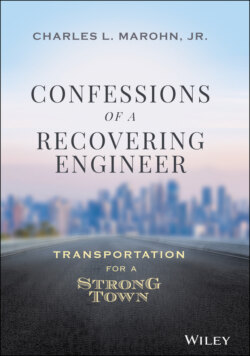Читать книгу Confessions of a Recovering Engineer - Charles L. Marohn Jr. - Страница 13
The Strong Towns Approach
ОглавлениеTraffic engineers are a critical part of designing transportation systems, but the values of the public need to dominate decision-making. Value decisions need to be stripped out of the design process and given over to nonprofessionals, preferably elected officials and the people living within the community— those directly affected by the design.
Table 1.2 gives an example of who should make what kind of decision during a street design process.
Elected officials must be given the ability to set the values for the project. It is their responsibility, on behalf of the people they serve, to establish the automobile design speed, the number of vehicles that should be accommodated, the size of vehicle that should be considered in the design, and the degree of deference that should be shown to people walking or biking at a given intersection. These are not design decisions; they are value decisions.
We must also insist that engineers use value-free descriptions for the work they are doing. If they are proposing to widen the street, it should be called a “street widening” and not a “street improvement.” If they are cutting down all of the trees adjacent to the street, it should be called “tree removal” and not brought forth as an “enhancement.” The goal for everyone is to communicate as clearly, factually, and value-free as possible. Elected officials must insist on this.
Table 1.2 Who Makes the Decision?
| Nonprofessionals | Technical Professionals |
|---|---|
| Design Speed | Pavement Thickness |
| Design Volume | Pavement Cross Slope |
| Design Vehicle Size | Lane Width |
| Intersection Priority | Bituminous Mixture |
The burden and responsibility of making value decisions should not rest with technical professionals. Traffic engineers are incapable of representing the complexity of human experience that needs to be considered in a street design. That is especially true when industry orthodoxy is adhered to. This is not so much a statement on the engineering profession as it is an acknowledgment that city streets are the frameworks of human habitat, a complex-adaptive environment that must harmonize many competing interests.
As I will demonstrate in upcoming chapters, if we align the design approach with the values of the community, we can reduce death, create places of greater prosperity, spend less money on transportation, and get a better functioning system. We can do all of this, but only if we address the underlying values of the design process. To build a strong and prosperous community, local leaders must assert their community's values and see them reflected in the transportation system.
State Street in Springfield is designed with the wrong values. Its purpose is to move a high volume of automobiles at speeds much higher than what is safe for that area. Instead, it should be redesigned to prioritize safety. The value decisions for State Street were made without presenting the value options to elected officials, let alone the community at large. Both almost certainly have different priorities.
More information on State Street in Springfield, including maps, photos, and supporting documentation, is available at www.confessions.engineer.
